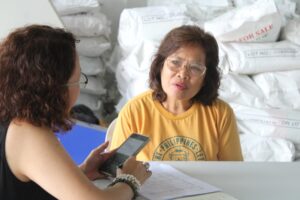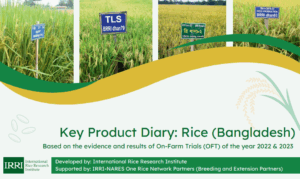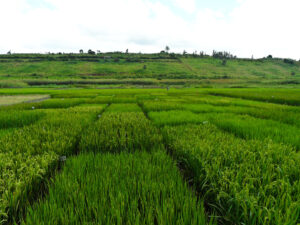Laser land leveling strongly complements sustainable rice production practices as it can help increase water, seed, and fertilizer use efficiency by at least 12, 27, and 10%, respectively. Already widely adopted in developed countries and recently in India and China, it is still not significantly adopted in countries such as Cambodia, the Philippines, Thailand, and Vietnam. The major reasons may be the lack of demonstration, operation, and management capability; little understanding of the benefits; the need to depreciate the relatively high cost of the service over a 5-year period; and the lack of policy advocacy to promote this technology.
Poor land consolidation, insufficient mechanization, including the lack of precision land leveling, and inefficient use of agronomic inputs are some of the major challenges in rice production. Significant unlevelness in rice field plots causes uneven water distribution leading to adverse effects such as hampered crop establishment and increased use of seed, water, fertilizer, and pesticide to compensate for the effects of an uneven field.
Land leveling is an important precondition for land preparation and a good seedbed or for land consolidation in agriculture, particularly for the humid tropics characterized by heavy rains and water scarcity in different seasons.
Most rice fields in Southeast Asian countries (SEA) are fragmented with small plot sizes of 0.1–2.0 hectares (ha). Small-sized and unleveled fields hamper mechanization and cause low energy efficiency and productivity in mechanized operations that can be counteracted by the benefits of using a combine harvester.
Expanding field size or removing field bunds is one of the key strategies for more effective farming in several countries. For instance, the “small farmer, large field” program is one of the promoted models of agricultural structural transformation in Vietnam. A similar farming model has also been piloted recently in India.
However, expanding field size is hindered by physical barriers such as unlevelness or topography. For a given slope of a field, as it becomes larger, the differences in elevation also get bigger, resulting in more adverse effects on the management of water, and other agronomic inputs.
On the other hand, the global rice value chain was recently driven by the need for sustainable production and consumption . Therefore, identifying sustainable technologies is essential to upgrade the value chain and benefit farmers and related stakeholders.
The Sustainable Rice Platform established twelve sustainable performance indicators representing sustainable impact areas, of which, profitability, agronomic use efficiency, and greenhouse gas (GHG) emission are commonly used as the economic and environmental indicators of a technology.
Land leveling is one of the major factors affecting spatiotemporal yield variability. In addition, leveling index significantly affects uniform crop establishment and boosts the potential yield of rice production. Laser-controlled land leveling (LLL) is a technology used for leveling a field within a certain degree of the desired slope throughout the field. Using laser beam from a transmitter and receiver attached to leveling bucket, the control box interprets the signal either to lift or not the leveling bucket attached to a tractor.
Its function is to detect automatically the unevenness in altitude of the field in order to move soil correspondingly from higher to lower spots attaining leveled field with very high precision. LLL therefore can help to optimize the field’s slope for optimum water management and crop growth. For example, an evenly flat surface is better for irrigated rice as most rice varieties can well grow in fields with standing water. On the other hand, some other crops, such as maize and sugarcane, need a leveled field to avoid erosion, and a certain slope to enable irrigation and drainage.
In addition, LLL helps optimize water management for the terrace field cropping system. Furthermore, with precisely leveled fields, the water can be controlled timely and optimally matched with the crop growth requirements. These advantages of LLL result in increasing water-use efficiency, crop productivity, and grain quality and decreasing weed problems. In the same way, the benefits of improved spatial and temporal management, increased of agronomic use efficiency and reduction of irrigated water are significant increase of energy efficiency and reduced GHG emissions in rice production.
In particular, less water substantially reduces methane emissions from rice production. LLL, therefore, plays a vital role in precision agriculture for spatial and agronomic input optimization.
The technology was originally developed around the world for the construction sector and large-scale agriculture and was adapted for use on smallholder farms in Asia around 2000. Given the benefits of LLL, this technology is considered an important technology for agriculture. The technology and benefits of LLL have been popularized through publications and project reports.
However, limited research reports exist on the LLL practices in the specific regions and sustainable indicators of LLL. Therefore, this study was conducted with the following objectives:
(i) assessment on LLL practices in Cambodia, Philippines, Thailand, Vietnam, and India; and
(ii) testing a hypothesis that LLL is a sustainable technology for rice production based on the indicators of agronomic input use efficiency, energy efficiency, emissions, and cost-benefit.
The usual practice in SEA is that LLL is applied to reform the field in dry soil conditions to have higher input-use efficiency.
This study was therefore conducted assuming dry-land leveling with specified conditions, such as leveling the field with a final elevation difference of 20–30 mm compared with the 150–250 mm unevenness in the original field without LLL.
As the analysis showed significant positive net balances of energy, GHG emissions, and cost-benefit ratios in its 5-year cycle of application, is a demonstration of how LLL is contributing to the sustainability of rice production. Besides the quantified benefits described in the analysis, LLL application enables farmers to enlarge field size by consolidating small fields into larger ones, and this allows the mechanization of rice production, leading to other benefits such as better crop stand and pest management, solving labor shortages, and increasing productivity, efficiency, and effectiveness.
This analysis illustrated that applying LLL in rice production can decrease the total energy required for rice production in SEA by 20–30%. Similarly, LLL application can diminish GHG emissions of rice production by 20–40%, as shown from a comparison between GHG emission decreases in this research and those reported. The added value from LLL applied for rice production (USD 90–118/ha/season) is in agreement with that reported. This is 10–13% of the total income of rice production in SEA.
LLL has already been widely adopted in developed countries such as the United States and Australia and recently in some Asian countries such as India and China. However, it is still not significantly adopted in countries such as Cambodia, the Philippines, Thailand, and Vietnam.
The major reasons may be the lack of demonstration, operation, and management capability; little understanding of the benefits; the need to depreciate the relatively high cost of the service over a 5-year period; and the lack of policy advocacy to promote this technology.
LLL can be more effective with the support of modern technologies. For example, a field topographic survey can be conducted through drone technology and fringe projection profilometryFurthermore, digital agricultural solutions such as EasyHarvest, which include a module for optimized scheduling of LLL can help to increase LLL effectiveness.
This study confirmed that laser land leveling can improve spatial and temporal management of rice production. Moreover, it illustrated that LLL strongly complements sustainable rice production practices as verified by its sustainable performance indicators. Despite the required inputs for machine production (depreciation) and fuel consumption of LLL, the net income, and balances of energy and GHG emission are substantially improved. LLL can help increase water, seed, and fertilizer use efficiency by at least 12, 27, and 10%, respectively.
In addition, it helps to reduce at least 20% of GHG emissions from the reduction of standing water in the field. These outputs generated net energy of 3.0–6.9 GJ ha−1; reduced GHG emission of 1,151–1,486 kg CO2-eq ha−1; and added an income of USD 52–84 ha−1 season−1 of rice production in the countries of this study.
The result demonstrated that LLL is a sustainable technology as well as strongly supports sustainable rice production. The study would lead to better adoption of this technology through a concerted effort of evidence-based promotion and dissemination.
Read the study:
Nguyen-Van-Hung, Balingbing C, Sandro, J. et al. (2022) Precision land leveling for sustainable rice production: case studies in Cambodia, Thailand, Philippines, Vietnam, and India. Precision Agric






